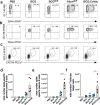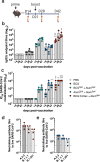A single dose, BCG-adjuvanted COVID-19 vaccine provides sterilising immunity against SARS-CoV-2 infection
- PMID: 34848711
- PMCID: PMC8633321
- DOI: 10.1038/s41541-021-00406-4
A single dose, BCG-adjuvanted COVID-19 vaccine provides sterilising immunity against SARS-CoV-2 infection
Abstract
Global control of COVID-19 requires broadly accessible vaccines that are effective against SARS-CoV-2 variants. In this report, we exploit the immunostimulatory properties of bacille Calmette-Guérin (BCG), the existing tuberculosis vaccine, to deliver a vaccination regimen with potent SARS-CoV-2-specific protective immunity. Combination of BCG with a stabilised, trimeric form of SARS-CoV-2 spike antigen promoted rapid development of virus-specific IgG antibodies in the blood of vaccinated mice, that was further augmented by the addition of alum. This vaccine formulation, BCG:CoVac, induced high-titre SARS-CoV-2 neutralising antibodies (NAbs) and Th1-biased cytokine release by vaccine-specific T cells, which correlated with the early emergence of T follicular helper cells in local lymph nodes and heightened levels of antigen-specific plasma B cells after vaccination. Vaccination of K18-hACE2 mice with a single dose of BCG:CoVac almost completely abrogated disease after SARS-CoV-2 challenge, with minimal inflammation and no detectable virus in the lungs of infected animals. Boosting BCG:CoVac-primed mice with a heterologous vaccine further increased SARS-CoV-2-specific antibody responses, which effectively neutralised B.1.1.7 and B.1.351 SARS-CoV-2 variants of concern. These findings demonstrate the potential for BCG-based vaccination to protect against major SARS-CoV-2 variants circulating globally.
© 2021. The Author(s).
Conflict of interest statement
The authors declare no competing interests.
Figures





Similar articles
-
High-Titer Neutralizing Antibodies against the SARS-CoV-2 Delta Variant Induced by Alhydroxyquim-II-Adjuvanted Trimeric Spike Antigens.Microbiol Spectr. 2022 Feb 23;10(1):e0169521. doi: 10.1128/spectrum.01695-21. Epub 2022 Feb 16. Microbiol Spectr. 2022. PMID: 35171046 Free PMC article.
-
Influence of Aerosol Delivered BCG Vaccination on Immunological and Disease Parameters Following SARS-CoV-2 Challenge in Rhesus Macaques.Front Immunol. 2022 Feb 9;12:801799. doi: 10.3389/fimmu.2021.801799. eCollection 2021. Front Immunol. 2022. PMID: 35222355 Free PMC article.
-
Bacillus Calmette-Guérin-induced trained immunity protects against SARS-CoV-2 challenge in K18-hACE2 mice.JCI Insight. 2022 Jun 8;7(11):e157393. doi: 10.1172/jci.insight.157393. JCI Insight. 2022. PMID: 35446790 Free PMC article.
-
Fiction and Facts about BCG Imparting Trained Immunity against COVID-19.Vaccines (Basel). 2022 Jun 23;10(7):1006. doi: 10.3390/vaccines10071006. Vaccines (Basel). 2022. PMID: 35891168 Free PMC article. Review.
-
[Novel vaccines against M. tuberculosis].Kekkaku. 2006 Dec;81(12):745-51. Kekkaku. 2006. PMID: 17240920 Review. Japanese.
Cited by
-
Influenza Vaccination Mediates SARS-CoV-2 Spike Protein Peptide-Induced Inflammatory Response via Modification of Histone Acetylation.Vaccines (Basel). 2024 Jul 1;12(7):731. doi: 10.3390/vaccines12070731. Vaccines (Basel). 2024. PMID: 39066369 Free PMC article.
-
Mucosal COVID-19 vaccines: Risks, benefits and control of the pandemic.World J Virol. 2022 Sep 25;11(5):221-236. doi: 10.5501/wjv.v11.i5.221. World J Virol. 2022. PMID: 36188733 Free PMC article. Review.
-
The rapid progress in COVID vaccine development and implementation.NPJ Vaccines. 2022 Feb 10;7(1):20. doi: 10.1038/s41541-022-00442-8. NPJ Vaccines. 2022. PMID: 35145102 Free PMC article. No abstract available.
-
Evaluation of BCG Vaccination and Plasma Amyloid: A Prospective, Pilot Study with Implications for Alzheimer's Disease.Microorganisms. 2022 Feb 12;10(2):424. doi: 10.3390/microorganisms10020424. Microorganisms. 2022. PMID: 35208878 Free PMC article.
-
Broadly neutralizing SARS-CoV-2 antibodies through epitope-based selection from convalescent patients.Nat Commun. 2023 Feb 8;14(1):687. doi: 10.1038/s41467-023-36295-5. Nat Commun. 2023. PMID: 36755042 Free PMC article.
References
Grants and funding
- 2007221/Department of Health | National Health and Medical Research Council (NHMRC)
- 1153493/Department of Health | National Health and Medical Research Council (NHMRC)
- 2007221/Department of Health | National Health and Medical Research Council (NHMRC)
- 2007221/Department of Health | National Health and Medical Research Council (NHMRC)
- 1153493/Department of Health | National Health and Medical Research Council (NHMRC)
LinkOut - more resources
Full Text Sources
Other Literature Sources
Miscellaneous

